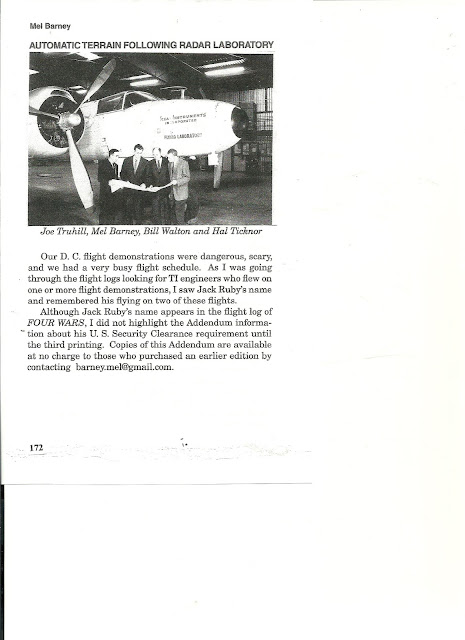JACK RUBY’S SECURITY CLEARANCE
A new edition of Mel Barney’s book “Four Wars” includes an Addendum entitled “Jack Ruby Had U.S.
Security Clearance,” and details how Jack Ruby had a Security Clearance that
permitted him to fly on a special Texas Instruments airplane.
The airplane, a B-26, which was identified as a “Texas
Instruments Incorporated – Flying Laboratory,” had special, newly developed
equipment – a “Automatic Terrain Following Radar Laboratory.”
Official records indicate that Ruby flew on the plane twice
in Washington DC
Author of the book, Mel Barney wrote, “During our Washington
D.C.
“On September 1, 1961 (see flight test log in Appendix,
Flights 144 and 145) Ticknor was the TI Engineer on Flt. 144 and on Flt 145
Barney was the TI Engineer…To fly on these demonstration flights, the observer
had to have a U.S. Security Clearance and a ‘Need to Know.’ Jack Ruby had these
clearances and I recognized Jack Ruby on Flight 145. I do not know when or how
he obtained these clearances which were usually controlled by the FBI or CIA .”
Not another person with the same name, Barney personally
knew Ruby and recalled him being on the flights.
“I became acquainted with Jack Ruby in the late 1950s,”
Barney writes. “As a program manager, I was often called upon to host visiting
engineers and managers who solved problems or negotiated contracts with TI.
Typically, I would take the customer or vendor to dinner and in many cases
entertain them after dinner. A favored spot to entertain these guests
(particularly the pilots) was Jack Ruby’s Carousel Club. The Carousel Club was
a strop club in downtown Dallas
“Our D.C. flight demonstrations were dangerous, scary, and
we had a very busy flight schedule. As I was going through the flight logs
looking for TI engineers who flew on one or more flight demonstrations, I saw
Jack Ruby’s name and remembered his flying on two of these flights.”
Barney also notes that, “Although Jack Ruby’s name appears
in the flight log of ‘Four Wars,’ I did not highlight the Addendum information
about his U.S. Security Clearance requirement until the third printing.”
According to Russ Baker in “Family of Secrets,” “Geophysical
Service, Inc., which later became Texas
Book Description:
Four Wars by Mel Barney (Merit Books, 2012, 137 pages)
Author:
Mel Barney’s life reads like a fascinting history lesson.
Born on the eve of the Great Depression in Shreveport ,
Louisiana CIA . He flies on
many dangerous flight tests. With CIA
assistance, he travels behind the Iron Curtain during the Cold War and
initiates a technology exchange which becomes part of the Nixon/Brezhnev
détente initiative. As the manger of the Texas Instruments international
marketing program he travels to fifty-four countries. His adventures include
many stories about the countries he visits including being kidnapped in Nigeria Jakarta Washington D.C. Dallas Dallas Fort
Worth


'For almost 50 years after the turn of the 20th century, the electronics industry had been dominated by vacuum tube technology. But vacuum tubes had inherent limitations. They were fragile, bulky, unreliable, power hungry, and produced considerable heat.
ReplyDeleteIt wasn't until 1947, with the invention of the transistor by Bell Telephone Laboratories, that the vacuum tube problem was solved. Transistors were miniscule in comparison, more reliable, longer lasting, produced less heat, and consumed less power. The transistor stimulated engineers to design ever more complex electronic circuits and equipment containing hundreds or thousands of discrete components such as transistors, diodes, rectifiers and capacitors. But the problem was that these components still had to be interconnected to form electronic circuits, and hand-soldering thousands of components to thousands of bits of wire was expensive and time-consuming. It was also unreliable; every soldered joint was a potential source of trouble. The challenge was to find cost-effective, reliable ways of producing these components and interconnecting them. One stab at a solution was the Micro-Module program, sponsored by the U.S. Army Signal Corps.'